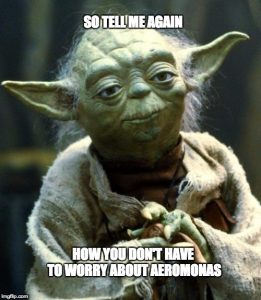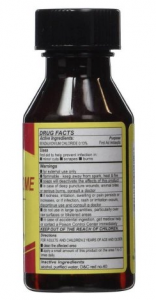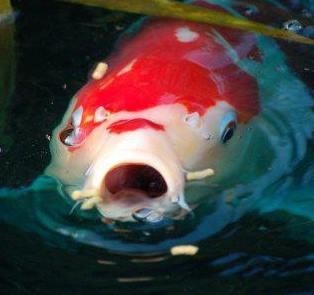What is Aeromonas?
Aeromonas hydrophilia is a common pond water bacteria. So common in fact, it is found in every single pond. No amount of water changes or chemical warfare will get rid of it.
When not being an opportunistic pathogen, it is useful for helping to maintain good water parameters by digesting fish poop.
When introduced into an immunocompromised koi, it causes the damage that too many koi enthusiasts are intimately familiar with.
When this bacteria finds it’s way into a situation where it shouldn’t be, it causes a host of illnesses in koi. Ulcer disease, also known as Hole in the Side disease, is the most notable.
As the name suggests, as the disease progresses from a white, pimple-like spot on a koi’s body, it ulcerates and creates an open sore in and on the koi.
This furunculosis (or Ana aki in Japanese) is the condition that manifests itself in those blood-ringed , scabless ulcers that can cause loss of scales, permanent scarring, septicemia, internal infection and death.
Unlike some other diseases, Ulcer disease on one koi does not signify an epidemic amongst an entire population. Other koi may get it, but it will be for the same or similar reasons that the koi in question gets it, namely:
- poor water conditions (large pH variance, increased ammonia and nitrite levels)
- stress
- injury (scrape, scratch or chemical) resulting in an entry into the epidermis
- parasitic infection that causes the secondary bacterial infection
For more information on Aeromonas and how to treat it, you can read our article Aeromonas, Your Koi and What You Can Do to Combat It.
What is “Aeromonas Alley”?
 Aeromonas Alley refers to the period of the year when winter makes way for spring and the water temperatures start to rise. It is usually in the 55-70ºF range.
Aeromonas Alley refers to the period of the year when winter makes way for spring and the water temperatures start to rise. It is usually in the 55-70ºF range.
As the water warms, Aeromonas bacteria become more active. Koi immune systems also become more active, but at a much slower rate than the harmful bacteria. This leaves a period where the bacteria are active and hungry for flesh to infect, while immune systems are still struggling to get up and running at peak effectiveness. This is when Koi are most susceptible to bacterial infections.
Koi owners will be at their most vigilant when the water temperatures are in this range. Even those koi kichi in the warmer southern states have to remain vigilant. A pond doesn’t need to be frozen over to be at risk when spring rolls around. Temperatures can still drop into the 50s and stay there until spring starts—which means they will have to deal with Aeromonas Alley.
You may not be able to stop Aeromonas, but there are means of limiting and dealing with its capacity to become an issue for your koi when they are at their most vulnerable.
Medicated Food
This was often a topic of debate amongst koi enthusiasts. Some used it as a panacea for safeguarding against Aeromonas Alley (and other potentially harmful bacteria or health threats). Others believed it was all just so much marketing and a waste of money.
But it is now a moot argument, as the Food and Drug Administration has placed regulations on medicated feed for animals—including that in fish food. Only vets have the capability to prescribe antibiotic-infused medicated food. This has caused many food manufacturers to stop the production of medicated foods altogether.
 However, there is an alternative to “medicated foods” that rely on prevention rather than “cure.” These probiotic-enhanced foods (like the Platinum Pro from Blue Ridge Koi and Goldfish) contain Primalac which have been scientifically proven to strengthen a koi’s immune system.
However, there is an alternative to “medicated foods” that rely on prevention rather than “cure.” These probiotic-enhanced foods (like the Platinum Pro from Blue Ridge Koi and Goldfish) contain Primalac which have been scientifically proven to strengthen a koi’s immune system.
Blue Ridge has also released their new Probiotic Plus feed, with elevated levels of Vitamin C that boosts the immune system even beyond that of Primalac. Along with the addition of Montmorillonite clay (commonly known as koi clay), which introduces much-needed trace elements that pond water lacks, it is an all around great Spring purchase for a koi’s health. Probiotic Plus is a preventative food, meant to boost koi immune systems and prevent infection from ever getting started.
There are many koi enthusiasts who make their own homemade blends of vitamin and mineral enriched feeds. The formulae might be slightly different, but the principle is the same—slow down bacterial threats while their koi’s immune system gets up to speed. Like this one from Next Day Koi customer, Sandy Campbell:
I like to mix a gallon zip loc bag of koi food with concentrated real orange juice, just enough to wet the pellets but not soak them. Mix in a child’s crushed Vitamin C and an entire head of crushed garlic. Mix it all well and keep in the refrigerator. This can be fed a few weeks before winter and when they start feeding again after winter. It’s packed with Vitamin C. I also like to feed small pieces of kiwi fruit as it has more Vitamin C than oranges. All this boosts their immune system.
Going Indoors
This is not always an option for koi owners with space limitations or without the requisite components to be able to effectively house their koi over winter. However, if it is possible, going indoors and being able to regulate the temperature to be higher than Aeromonas Alley range can mitigate the likelihood of it being an issue.
Ulcer Disease Preparation
Prevention is ALWAYS better—and cheaper—than cure. Having said that, being prepared to quickly and effectively treat any symptoms that arise is a necessity. Having supplies and medications ready to do topical and injectable antibiotic treatments goes a long way in limiting any damage that the disease can cause.
Quarantining—Having a separate tank or “hospital pond” where the water temperature and parameters can be quickly and easily regulated is extremely helpful. Higher water temperatures (80-83ºF) can help to bump the koi’s immune system. It is also helpful in feeding correct amounts and creating an anti-bacterial bath.
Salt—Adding 3lbs/100gallons of salt can slow fluid and electrolyte loss from the ulcer. It can also help eliminate parasites (which could be one of the causes of the ulcers).
 Chemicals—Hydrogen peroxide will clean out the wound. Some enthusiasts advocate the use of potassium permanganate or solutions of formalin/formaldehyde as well as Merthiolate or mercurochrome.
Chemicals—Hydrogen peroxide will clean out the wound. Some enthusiasts advocate the use of potassium permanganate or solutions of formalin/formaldehyde as well as Merthiolate or mercurochrome.
Medication—Putting a topical antibacterial ointment (like Neosporin or Polysporin) on the fish or bathing it in tricide-Neosporin mixture can help to combat and stop other forms of infection entering the koi, it but it won’t cure it. Injectable antibiotics (like Baytril)—injected behind the pectoral fin, just in front of the anal vent—have proven effective in curing ulcers.
It is worth noting here that there is a wide range of treatment styles and products that have been successfully adopted by koi enthusiasts. A professional opinion is a good first option to take.
Summer Conditions
The same standards that are used to keep koi hale and hearty during the warmest months of the year are the ones that will help to stave off Aeromonas in the Spring.
- Clean pond bottom,
- Clean filters,
- Proper water parameters,
- Quarantine all fish before adding them to the pond,
- Proper water changes.
Winter Prep
It may seem counterintuitive that your winter preparation can impact your spring, but it is true.
A fastidious winter prep will set your koi and pond up for a smoother transition into the spring. A healthy immune system, even if it is slower in winter, means that your koi come out by and large with the same healthy immune system. It builds on itself, giving your koi a better fighting chance against Aeromonas (and other bacteria) as it becomes more active.
Here is a handy koi pond winter prep checklist.
Cleaning up the Alley
We have stressed more than once above, but it is worth repeating the steps to take to minimize the likelihood of Aeromonas getting a foothold in any of your koi come Spring.
- Cleanliness—this counts in winter when you are shutting up shop and in the spring when you open it back up. Clean filters (and low levels of organic waste) are key to success.
- Routine water changes—keeping the water fresh (and dechlorinated of course) can keep the bacteria in low concentrations as they start to go dormant.
- Oxygen levels—Oxygen deprivation can contribute to disease as well as provide an environment for bacteria to replicate.
- pH levels—crazy pH fluctuations will wreak havoc with an immune system. Between 7-9 and STABLE morning to night, is where you want your levels to be.
- New koi—don’t add any without rigorous quarantine, and especially not late in the season
- Diet—find the right balance of vitamins and minerals and use according to need.
- Don’t overfeed—feed recommended amounts and according to the water temperature schedule. With less decaying organics in the water, there is less for Aeromonas to thrive on.
Aeromonas and Aeromonas Alley are cause for some trepidation amongst koi owners but the bacteria can be controlled as can the overall health of your koi to lessen the chance of Aeromonas becoming an active pathogen.


Well poop. I think that is what my new koi has. He is in quarantine with other fish, I’ve recently started treating the tank with Seachem’s ParaGuard. Should I separate him from the other fish? Any product or parameter suggestions? I rescue animals and picked up 2 koi and a comet from the LFS because they were going to “cull” them. They are unattractive but that is no reason for why they were sitting in a stock tank with no air, circulation, or filtration, but plenty of poo and algae.
There are a few different treatments you can try, including topical and injectable antibiotics. This article covers the treatment options – https://nextdaykoi.com/koi-fish-facts/aeromonas-your-koi-and-what-you-can-do-to-combat-it/
What about aeromonas veronii? That is not commonly found in ponds and is very resistant to treatment. It showed up in a fish necropsy that I sent to UC Davis lab. A fish from NDK.
How long had you had the fish in your possession before the necropsy samples were submitted?
4.5 months before it died after losing 16 of 25 fish bought from NDK in the first 3 months without any losses of pre-existing fish. A lot of them had no signs aside from not feeding well and hanging on the bottom. Total fish loss more than $350. Total treatment purchases more than $1000. Total grief and anxiety priceless. I did contact NDK several times and played phone and email tag. Did talk to someone there who wasn’t customer service and couldn’t help me but thought it was due to the “low”salinity I maintained in the pond. I understand that these fish were bought before the aeromonas alley but to lose so many and none of my other fish was frustrating and very painful. The pathologist at UCDAVIS said this form of aeromonas had been traced to Israel and back to the US.
Hey Nancy. Again I am very sorry that you had these problems with our fish. A few comments from our side.
The individuals from our company that you spoke with were all customer service representatives, you did not speak with anyone else from the company. We are sorry that there was so much phone tag, but as a small company of just a few individuals we cannot always get to every phone call, especially during the spring when we are at our busiest. We attempted to call you back on numerous occasions and were not able to reach anyone.
We have moved tens of thousands of fish from our sole Israeli supplier through our facilities this year, and have not had any incidence of widespread aeromonas.
You mention that the fish were purchased before “aeromonas alley”, but your fish were purchased and shipped around February/March if I remember correctly. The temperatures in your area are still very cold during this time year, meaning that there was some additional stress the fish would likely have to deal with, depending on where you kept them.
Again I am very sorry that you had to deal with this. In a perfect world our company and all other koi dealers in the world would be able to shield customers from the risk of aeromonas, but the reality is that is not the way aeromonas works and we are not able to completely eliminate the risk of aeromonas, only better educate our customers about what it is and how to deal with it. If you would like to share any further information about your experience and what you learned from it, we would be happy to hear. Hopefully it may help other customers when they face the same problems and issues you went through.
Well, I had the water heated to about 55-60 so there shouldn’t have been too much cold shock. As mentioned in my email the second shipment had very lethargic fish and most of those died within a month but of course after the 14 day guarantee. I don’t know if there is any recourse but sad to lose so many so fast without loss of existing fish. It isn’t just about the money- it was incredibly distressing to wonder who was going to die next. I used Proform-C as directed several times, increased the salinity, used Melafix, additional beneficial bacteria, Aqua medzyme the enzymes that are supposed to compete with the bad bacteria, used potassium permanganate, frequent water changes, tricide neo dips, salt dips, Medi-koi medicated food, Microbe-lift Broad spectrum disease treatment, praziquantel, and several other treatments I can’t remember at this time. I purchases all these treatments when your fish started dying so again, very frustrating. I know its long after the 14 day window but I had hopes for some reimbursement for all the trouble and expense I went through. I have now have a greenhouse cover over the pond and with a heater and am able so far to keep the water temperature above 72 degrees. This has been a long hard haul and I wish I knew then what I know now. Your customer service within the 2 week window was excellent. I hope it remains so.
I’ll have someone reach out to you and see if we can offer some sort of compensation for your troubles.
Nancy, it’s no consolation but I purchased two lovely tosai asagi from K2tW this summer. After the quarantine period, in a salted tank, they were placed in the pond with my two year olds (that I had raised from 2 to 3 inches to 16 to 20 inches over the course of 18 months). Every one was doing so well and loving the warm late summer (temps have been well above 50 until yesterday 10/26). However, on October 17th I came home to find the two tosai dead and my big (878 gram) hi asagi in distress (she died within an hour of being found). I just got the necropsy report this morning and all three showed heavy growth of A. veronii on direct culture from samples taken of gill, liver and intestine. So this appears not to be just a NDK issue unless they are buying from the same supplier. I’m devastated as I retire next spring and had hopes of spending the year raising asagi. Now I have to decide if it’s worth the emotional distress of starting all over again or just living with a 2500 gallon hole in my yard…
Vulnavia-
I have been told by another Koi dealer (who has had knowledge of this) that if you heat the fish to 85 F for two weeks they might become free of this horrible bug. Two to three months quarantine under regular circumstances does not guarantee they will be OK or won’t spread it to other fish. With 39 koi it is not feasible for me to do this altho I have a 100gal tank tank with a 2000 gal filter, robust aeration and a heater that is keeping the water warm and if I ever get any new koi I will try this approach although the treatment might kill them. I was also advised to kill them all, sterilize the entire system and start over. Not an option, period.
I would not be able to have a pond and not have fish as they bring me so much joy. However, that joy is tempered by what I have been through and the learning about this after the fact. I hope you are able to bring yourself to obtain more fish and find your joy again.
To clarify- my main system is about 2000gal with an 8000 gal. bead filter and a beautiful bakke type filter. The 100 gal tank is for quarantine and currently holds my “smalls” under 7 inches. The cost of electricity is high even with solar but my peace of mind with not having to go through another aeromonas alley outbreak is priceless.
[…] stability is vital for preventing conditions like “Aeromonas Alley,” a temperature range where koi are highly susceptible to harmful […]